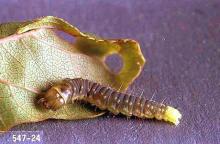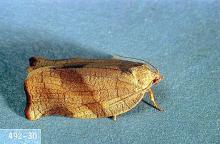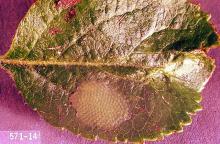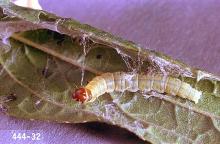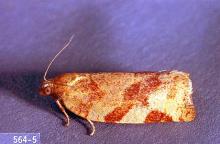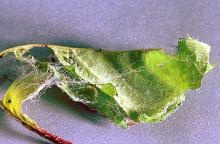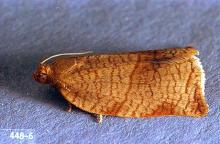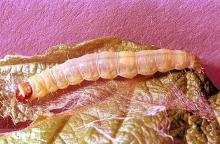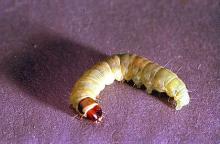Includes
European leafroller (Archips rosana)
Fruittree leafroller (Archips argyrospila)
Obliquebanded leafroller (Choristoneura rosaceana)
Pandemis leafroller (Pandemis pyrusana)
Pest description and crop damage There are several species of leafroller pests in tree fruits. The larvae of these moth species use native ornamental plants as well as fruit trees as hosts. They all cause similar damage to the trees, but differ in their appearance and, more importantly, in their life cycle. The principal leafroller pests of fruit trees are divided into single-generation moths such as the fruittree leafroller and the European leafroller, and two-generation moths such as the obliquebanded leafroller and the pandemis leafroller.
Adults of these species vary in color, ranging from fawn-colored to dark brown. There are distinctive bands or mottling on the wings. Wingspans range from 0.5 to 1inch. The larvae of these species are all green caterpillars with a light brown to black head, depending on the species. Mature larvae may measure 0.75 to 1-inch in length. Larvae roll and tie leaves together for shelter and feeding on the leaves. Feeding on growing points on young plants can promote undesirable branching. Newly hatched larvae may work into blossoms and damage developing fruit, which then aborts and falls off the tree. Larvae of the summer generation of the pandemis and the obliquebanded leafroller may feed on the surface of fruit just before harvest.
Biology and life history The single generation leafrollers overwinter as egg masses on twigs and branches. Eggs hatch in spring as buds are opening until petal fall. Larvae feed for 4 to 6 weeks, then pupate in the rolled leaves and emerge as moths in early summer. The overwintering eggs are laid in July.
The two-generation leafrollers overwinter as immature larvae under the bark on scaffold branches of a variety of host plants. Larvae may feed during warm periods in winter but become most active in spring with onset of new growth. They feed for several weeks and then pupate in rolled leaves. Adult moths emerge in late April to May, mate and then lay eggs for the second generation. These larvae hatch in early summer and do the most fruit damage.
Pest monitoring Observe early spring growth for rolled leaves and feeding damage on new growth. There are species-specific pheromone lures available for commercial growers for leafroller moths. Traps baited with these lures are effective in monitoring moth flight periods and timing spray applications. Note that trap catch numbers are not always correlated with fruit damage at harvest.
Management-biological control
Very low temperatures in winter and late spring frosts can significantly reduce overwintering populations of larvae. Spiders and parasitic wasps, as well as predators like lacewings, greatly reduce leafroller populations throughout the year.
Management-cultural control
Hand-pick rolled leaves containing larvae or pupae. Removal of overwintering sites, such as dropped and rolled leaves on the ground or leaves plastered to tree trunks, can reduce next year's population.
Management-chemical control: HOME USE
Dormant-season spray
Apply sprays using enough water to cover the entire tree thoroughly including small limbs. Apply only during dormant or delayed-dormant period.
- horticultural mineral oil-Some formulations OMRI-listed for organic use.
Growing-season spray
- azadirachtin (neem extract)-Some formulations are OMRI-listed for organic use.
- Bacillus thuringiensis var. kurstaki-Some formulations are OMRI-listed for organic use.
- carbaryl-Highly toxic to bees.
- esfenvalerate-Highly toxic to bees.
- gamma-cyhalothrin-Highly toxic to bees.
- horticultural mineral oil-Some formulations OMRI-listed for organic use.
- insecticidal soap-Not recommended for use on yellow-skin nectarine varieties. Some formulations OMRI-listed for organic use.
- kaolin clay-Repels some insect pests when applied as a spray to leaves, stems, and fruit. OMRI-listed for organic use.
- lambda-cyhalothrin-Highly toxic to bees.
- plant-derived essential oils-Some have shown efficacy against leafrollers. Some formulations are OMRI-listed for organic use.
- pyrethrins-Highly toxic to bees. Some formulations are OMRI-listed for organic use.
- spinosad-Highly toxic to bees. Some formulations are OMRI-listed for organic use.
- zeta-cypermethrin-Highly toxic to bees.
Management-chemical control: COMMERCIAL USE
For orchards with a history of leafroller problems, direct cover sprays in the early spring at the overwintering generations for best control. Summer generations of leafrollers become more difficult to control.
Petal fall, spring and summer sprays
- Bacillus thuringiensis var. kurstaki-Check label for rates. REI 4 hr. PHI 0 days. Nontoxic to bees. This biologically derived material is slow acting and requires good coverage and multiple applications in order to be effective. Apply when forecast calls for warm daily temperatures. This material is less effective during cool weather when larvae are not actively eating. Some formulations are OMRI-listed for organic use.
- chlorantraniliprole (Altacor 35WDG) at 3 to 4.5 oz/A. REI 4 hr. PHI 10 days.
- flubendiamide + buprofezin (Tourismo) at 10 to 14 fl oz /A. REI 12 hr. PHI 14 days.
- methoxyfenozide (Intrepid 2F) at 8 to 16 fl oz/A. REI 4 hr. PHI 7 days.
- spinetoram (Delegate 25WG) at 4.5 to 7 oz/A. REI 4 hr. PHI 1 day.
- spinosad (Entrust 80W) at 1.25 to 2.5 oz/A. REI 4 hr. PHI 1 day. Results are best when applied at petal fall. OMRI-listed for organic use. May act slowly.
Resistance management Leafrollers can develop resistance rapidly to chemical controls. Do not treat consecutive generations with pesticides representing the same chemical group or mode of action. Spinetoram and spinosad are group 5 products. Chlorantraniliprole and flubendiamide are group 28 products.


